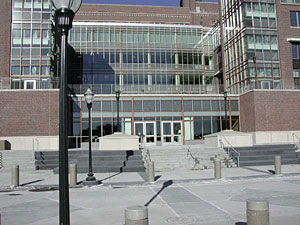January 3, 2005
 |
| Gov. Pawlenty's proposal includes $100 million each for the University of Minnesota and the Minnesota State Colleges and Universities System. (MPR file photo) |
St. Paul, Minn. — Pawlenty's list of state-financed building projects closely follows his outline from last year, with a slight boost for increased construction costs and a few new projects, including a nursing home facility for elderly sex offenders in state custody. Pawlenty predicted the breadth of his proposal would earn bipartisan support.
"But you go down the list, whether it's education, whether it's public safety, environment and natural resources, water, veterans, World War II memorial, I mean, I think you'd be... to look at this list and say, 'I'm opposed to this bill,' would be an odd thing. I mean, this is a bill filled with good stuff," Pawlenty said.
Senate DFLers agree, but say they'd like even more. The governor's plan is packed with money for higher education projects, for the Minnesota Zoo, for more prison beds, for reducing homelessness and for environmental conservation. It also supports the controversial Northstar commuter rail line, connecting Minneapolis and its northwestern suburbs.
Sen. Keith Langseth, DFL-Glyndon, who chairs the Senate Capital Investment Committee, says the Senate is likely to advance a bonding bill that approaches $1 billion. And he says Democrats will act sooner rather than later.
"We're already basically a year late," according to Langseth. "And if we were to push to the end of session, which many people have suggested, it would just push a lot of those projects off for one more year. So we fully intend to do our part and have our proposal voted on by the end of January."
Lawmakers failed to agree on a bonding bill last year, which has cost many projects a year of construction time and created uncertainty around others. But Langseth says DFL gains in last fall's elections have given them new leverage for passing a substantial bill and passing it early.
Matt Entenza of St. Paul leads the DFL House minority, which came within two seats of snatching the majority. He says the governor's plan is too slight and, in particular, underfunds higher education projects.
"Our goal is always going to be to move things forward. But Republicans have to learn there's got to be negotiations. And if there's a disappointment, it's not that the governor's proposing a bonding bill -- we're pleased that he is -- it's that it's essentially the same bill brought back with increases in construction costs, which is the price of delay," Entenza said.
DFL votes are important since the bonding bill requires the state to borrow for most of the construction costs, and going into debt requires three-fifths super-majorities to pass. That means Democratic votes are indispensable if something is expected to pass this year.
Pawlenty seems to have recognized that reality. He's offered to expand the size of the borrowing if lawmakers propose a way to repay the debt. Among House Republicans, there may also be a new willingness to borrow and spend more.
Dan Dorman of Albert Lea, the incoming chair of the House Capital Investment Committee, is widely considered a moderate, and he acknowledges that last year's House proposal was much slimmer than either the Senate's or the governor's.
"I think we had kind of an artificially low ceiling last year. There was a ceiling above it. I think you'll see that ceiling raised, but we don't want to add a second floor to the house. I think it'll come up but it's not going to go to a billion dollars. I think the governor's numbers are very close to where I think we can responsibly expect to be," Dorman said.
Dorman will have to walk a fine line between the fiscal conservatives in his own party who favor less spending, and the newly-emboldened Democrats whose votes are crucial. Any increase in state borrowing ultimately adds to the state's projected budget shortfall -- already predicted to hit at least $700 million over the next two years.







